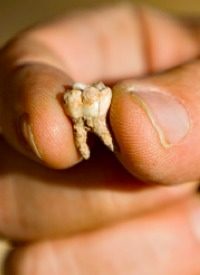
Avi Gopher, the expedition’s lead archaeologist, told Agence France-Presse (AFP) that the teeth were found in a cave east of Tel Aviv that was in use up until about 200,000 years ago, and were “scattered through the layers of the cave, some in the deeper part, that is to say from 400,000 years and through all kinds of other layers that can be up to 200,000 years. The oldest are 400,000 years old.”
Gopher said the discovery, which was first made in 2006, challenges the widely held scientific view that Africa was the birthplace of modern humanity. “It is accepted at the moment that the earliest Homo sapiens that we know is in east Africa and is 200,000 years old, or a little less,” he told AFP. “We don’t know of anywhere else where anyone claims to have an earlier Homo sapiens.”
Gopher, whose team has been excavating the prehistoric Qesem Cave in central Israel for the past four years, said that while they cannot be certain of the significance of their finds without further research, dating of materials inside the cave indicate that the human remains found there are the oldest uncovered anywhere. “This conclusion may be of great importance because it may be a first hint at changing some of the paradigms [used to think about] human evolution,” he said.
However, some scientists remain skeptical of the find, speculating that the remains are most likely of prehistoric near-human Neanderthals. “According to today’s accepted scientific theories,” reported the Associated Press, “modern humans and Neanderthals stemmed from a common ancestor who lived in Africa about 700,000 years ago. One group of descendants migrated to Europe and developed into Neanderthals, later becoming extinct. Another group stayed in Africa and evolved into Homo sapiens—modern humans.”
One such researcher, Sir Paul Mellars, a prehistory expert at Cambridge University, called the possibility that the remains are human “very tenuous and frankly rather remote,” explaining that because teeth can be an unreliable indicators of origin, an analysis of skull remains from the cave would provide a more definite identity of the species.
But a scientific report published in the American Journal of Physical Anthropology noted that none of the teeth from the cave “shows a suite of Neanderthal characters, [although] few traits may suggest some affinities with members of the Neanderthal evolutionary lineage.” The report concluded that “the balance of the evidence suggests a closer similarity with the Skhul/Qafzeh dental material,” referring to other archaeological sites in Israel where other fossils of early modern Homo sapiens were discovered.
Gopher said he remains confident that his team will ultimately uncover skulls and bones confirming that the teeth are modern human remains, predicting that the discovery could go as far as changing the “whole picture of evolution.”
Photo of ancient tooth discovered east of Tel Aviv: AP Images


